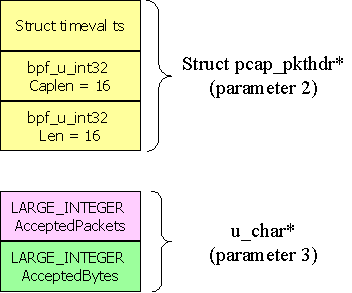
为了使用这个特性,编程人员必须打开一个适配器,并且,可以使用 pcap_setmode() 将它设置为统计模式(statistical mode)。特别注意,必须使用MODE_STAT来作为这个函数的mode参数。
在统计模式下,编写一个用于监听TCP网络流量的程序并不复杂,代码也不多。下面的范例程序将展示如何实现这个程序。
/* * Copyright (c) 1999 - 2005 NetGroup, Politecnico di Torino (Italy) * Copyright (c) 2005 - 2006 CACE Technologies, Davis (California) * All rights reserved. * * Redistribution and use in source and binary forms, with or without * modification, are permitted provided that the following conditions * are met: * * 1. Redistributions of source code must retain the above copyright * notice, this list of conditions and the following disclaimer. * 2. Redistributions in binary form must reproduce the above copyright * notice, this list of conditions and the following disclaimer in the * documentation and/or other materials provided with the distribution. * 3. Neither the name of the Politecnico di Torino, CACE Technologies * nor the names of its contributors may be used to endorse or promote * products derived from this software without specific prior written * permission. * * THIS SOFTWARE IS PROVIDED BY THE COPYRIGHT HOLDERS AND CONTRIBUTORS * "AS IS" AND ANY EXPRESS OR IMPLIED WARRANTIES, INCLUDING, BUT NOT * LIMITED TO, THE IMPLIED WARRANTIES OF MERCHANTABILITY AND FITNESS FOR * A PARTICULAR PURPOSE ARE DISCLAIMED. IN NO EVENT SHALL THE COPYRIGHT * OWNER OR CONTRIBUTORS BE LIABLE FOR ANY DIRECT, INDIRECT, INCIDENTAL, * SPECIAL, EXEMPLARY, OR CONSEQUENTIAL DAMAGES (INCLUDING, BUT NOT * LIMITED TO, PROCUREMENT OF SUBSTITUTE GOODS OR SERVICES; LOSS OF USE, * DATA, OR PROFITS; OR BUSINESS INTERRUPTION) HOWEVER CAUSED AND ON ANY * THEORY OF LIABILITY, WHETHER IN CONTRACT, STRICT LIABILITY, OR TORT * (INCLUDING NEGLIGENCE OR OTHERWISE) ARISING IN ANY WAY OUT OF THE USE * OF THIS SOFTWARE, EVEN IF ADVISED OF THE POSSIBILITY OF SUCH DAMAGE. * */ #include <stdlib.h> #include <stdio.h> #include <pcap.h> void usage(); void dispatcher_handler(u_char *, const struct pcap_pkthdr *, const u_char *); void main(int argc, char **argv) { pcap_t *fp; char errbuf[PCAP_ERRBUF_SIZE]; struct timeval st_ts; u_int netmask; struct bpf_program fcode; /* 检查命令行参数的合法性 */ if (argc != 2) { usage(); return; } /* 打开输出适配器 */ if ( (fp= pcap_open(argv[1], 100, PCAP_OPENFLAG_PROMISCUOUS, 1000, NULL, errbuf) ) == NULL) { fprintf(stderr,"\nUnable to open adapter %s.\n", errbuf); return; } /* 不用关心掩码,在这个过滤器中,它不会被使用 */ netmask=0xffffff; // 编译过滤器 if (pcap_compile(fp, &fcode, "tcp", 1, netmask) <0 ) { fprintf(stderr,"\nUnable to compile the packet filter. Check the syntax.\n"); /* 释放设备列表 */ return; } //设置过滤器 if (pcap_setfilter(fp, &fcode)<0) { fprintf(stderr,"\nError setting the filter.\n"); pcap_close(fp); /* 释放设备列表 */ return; } /* 将接口设置为统计模式 */ if (pcap_setmode(fp, MODE_STAT)<0) { fprintf(stderr,"\nError setting the mode.\n"); pcap_close(fp); /* 释放设备列表 */ return; } printf("TCP traffic summary:\n"); /* 开始主循环 */ pcap_loop(fp, 0, dispatcher_handler, (PUCHAR)&st_ts); pcap_close(fp); return; } void dispatcher_handler(u_char *state, const struct pcap_pkthdr *header, const u_char *pkt_data) { struct timeval *old_ts = (struct timeval *)state; u_int delay; LARGE_INTEGER Bps,Pps; struct tm *ltime; char timestr[16]; time_t local_tv_sec; /* 以毫秒计算上一次采样的延迟时间 */ /* 这个值通过采样到的时间戳获得 */ delay=(header->ts.tv_sec - old_ts->tv_sec) * 1000000 - old_ts->tv_usec + header->ts.tv_usec; /* 获取每秒的比特数b/s */ Bps.QuadPart=(((*(LONGLONG*)(pkt_data + 8)) * 8 * 1000000) / (delay)); /* ^ ^ | | | | | | 将字节转换成比特 -- | | 延时是以毫秒表示的 -- */ /* 得到每秒的数据包数量 */ Pps.QuadPart=(((*(LONGLONG*)(pkt_data)) * 1000000) / (delay)); /* 将时间戳转化为可识别的格式 */ local_tv_sec = header->ts.tv_sec; ltime=localtime(&local_tv_sec); strftime( timestr, sizeof timestr, "%H:%M:%S", ltime); /* 打印时间戳*/ printf("%s ", timestr); /* 打印采样结果 */ printf("BPS=%I64u ", Bps.QuadPart); printf("PPS=%I64u\n", Pps.QuadPart); //存储当前的时间戳 old_ts->tv_sec=header->ts.tv_sec; old_ts->tv_usec=header->ts.tv_usec; } void usage() { printf("\nShows the TCP traffic load, in bits per second and packets per second.\nCopyright (C) 2002 Loris Degioanni.\n"); printf("\nUsage:\n"); printf("\t tcptop adapter\n"); printf("\t You can use \"WinDump -D\" if you don't know the name of your adapters.\n"); exit(0); }
在启动统计模式前,用户需要设置一个过滤器,以定义要监听的数据流。详细内容请参考 过滤表达式语法 。如果没有设置过滤器,那么,所有的数据流量都将会被监听
过程
接口描述符(the interface descriptor)开始工作在统计模式下。注意 pcap_open() 函数的第4个参数( to_ms ):它定义了统计残阳的时间间隔。回调函数将在每一个to_ms时间,收到由驱动发来的计算好的采样数据。这些采样数据将通过回调函数的第2个和第3个参数传递,如下所示

它提供了两个64位的计数器,分别记录在最后一个时间间隔内,收到的数据包的数量和字节总数。
在这个范例中,适配器打开后的超时时间设置为1000毫秒。这就意味着dispatcher_handler()每隔1秒就会被调用一次。这里的过滤器被设置为只监视TCP包。然后, pcap_setmode() 和 pcap_loop() 被调用。注意,一个指向timeval结构的指针,作为user参数传递给函数 pcap_loop() 。这个结构体会被用来存储时间戳,以便计算两次采样的时间间隔。 dispatcher_handler() 会使用这个时间间隔来获得每秒的比特数(bps)以及每秒的数据包数量(pps),并将它们的值打印在屏幕上。
最后,我们想说,这个范例程序比传统的捕获和统计流量的程序都要高效,因为传统的程序都在用户层进行。静态模式需要最小的数据包拷贝和上下文交换,因此,CPU的性能会最优,而且,内存的需求量也会很少。
![]() documentation. Copyright (c) 2002-2005 Politecnico di Torino. Copyright (c) 2005-2007
CACE Technologies. All rights reserved.
documentation. Copyright (c) 2002-2005 Politecnico di Torino. Copyright (c) 2005-2007
CACE Technologies. All rights reserved.
2007 Translated By CoffeeCat Studio